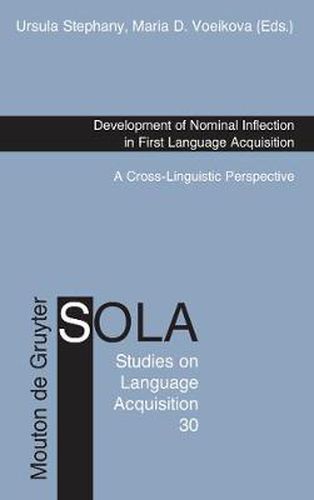Readings Newsletter
Become a Readings Member to make your shopping experience even easier.
Sign in or sign up for free!
You’re not far away from qualifying for FREE standard shipping within Australia
You’ve qualified for FREE standard shipping within Australia
The cart is loading…






This book deals with the emergence of nominal morphology from a cross-linguistic perspective and is closely related to Development of Verb Inflection in First Language Acquisition (ed. by D. Bittner, W. U. Dressler, M. Kilani-Schoch) both methodologically and theoretically. Each of the fourteen contributions studies the early development of the fundamental inflectionally expressed categories of the noun (number, case, gender) in one of the languages belonging to different morphological types (isolating, fusional-inflecting, agglutinating, root inflecting) and families (Germanic, Romance, Slavic/Baltic, Greek, Finnic, Turc, Semitic, Indian American). The analyses are based on parallel longitudinal observations of children in their second and early third year of life as well as their input. The focus lies on the transition from a pre-morphological to a proto-morphological stage in which grammatical oppositions and so-called mini-paradigms begin to develop. The point at which children start to discover the morphological structure of their language and the speed with which they develop inflectional distinctions of lexical items has been found to be dependent on the morphological richness of the input language on the paradigmatic as well as the syntagmatic axis of linguistic structure. The findings are interpreted within non-nativist theoretical frameworks (Natural Morphology, Usage-based theories).
$9.00 standard shipping within Australia
FREE standard shipping within Australia for orders over $100.00
Express & International shipping calculated at checkout
This book deals with the emergence of nominal morphology from a cross-linguistic perspective and is closely related to Development of Verb Inflection in First Language Acquisition (ed. by D. Bittner, W. U. Dressler, M. Kilani-Schoch) both methodologically and theoretically. Each of the fourteen contributions studies the early development of the fundamental inflectionally expressed categories of the noun (number, case, gender) in one of the languages belonging to different morphological types (isolating, fusional-inflecting, agglutinating, root inflecting) and families (Germanic, Romance, Slavic/Baltic, Greek, Finnic, Turc, Semitic, Indian American). The analyses are based on parallel longitudinal observations of children in their second and early third year of life as well as their input. The focus lies on the transition from a pre-morphological to a proto-morphological stage in which grammatical oppositions and so-called mini-paradigms begin to develop. The point at which children start to discover the morphological structure of their language and the speed with which they develop inflectional distinctions of lexical items has been found to be dependent on the morphological richness of the input language on the paradigmatic as well as the syntagmatic axis of linguistic structure. The findings are interpreted within non-nativist theoretical frameworks (Natural Morphology, Usage-based theories).